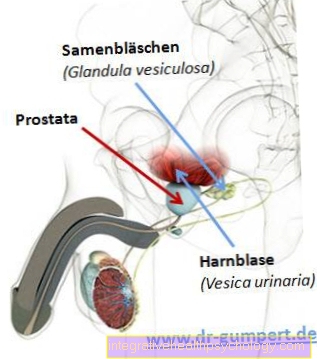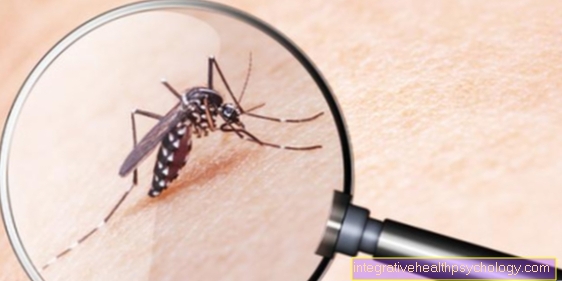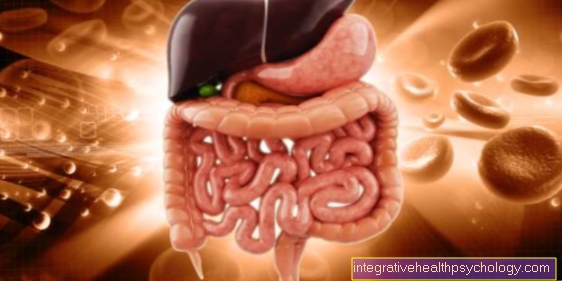Lactose intolerance symptoms
Synonyms
Lactose intolerance, lactose intolerance, lactose malabsorption, alactasia, lactose deficiency syndrome
engl .: lactose intolerance
Also read:
- Latose intolerance
- Latose intolerance diet
Symptoms of lactose intolerance
Lactose intolerance often goes with stomach pain and indigestion. This is because the lactose can only then be broken down and digested in the large intestine. Two different processes take place there:
An accumulation of lactose in the small intestine creates a higher osmotic pressure, so that less water is withdrawn from the stool. From this can diarrhea result. On the other hand, fermentation takes place through the colon flora, during which fatty acids, carbon dioxide, hydrogen, bacterial toxins (Toxins) as well as methane. On the one hand, this gas formation leads to characteristic Flatulence (Meteorism) and abdominal pain; on the other hand, these gases and toxins can get into the blood via the intestines and lead to further non-specific symptoms there. More symptoms can be Vomit, Headache, tiredness, difficulty concentrating or Allergies be. Cardiac arrhythmias can also occur very rarely.
Also read the article about lactose.
When do the symptoms appear?
The symptoms of lactose intolerance occur when products containing milk sugar (lactose) are consumed. Lactose is mainly found in milk and dairy products. So, for example, the symptoms occur in patients who cannot metabolize lactose after eating the following foods: butter, milk, Buttermilk, kefir, cream, milk chocolate, cheese, Quark, yogurt, Mascarpone and ice.
The following applies to cheese the less lactose contained in the cheese is the longer it has matured. Hard cheese usually contains relatively little lactose and is easy to digest, whereas soft cheese contains a relatively large amount of lactose.
Whether, in what intensity and in what amount symptoms occur differs from person to person and depends on how much Residual activity of the enzyme that the lactose is still metabolized. Lactose intolerance does not mean that lactase, i.e. the enzyme that can break down lactose, is no longer available. In Central Europe in particular, however, their activity decreases significantly over the course of life, so that larger amounts of the above-mentioned products can no longer be adequately metabolized.
Duration of symptoms
How long the symptoms of lactose intolerance last after consuming milk sugar is very differently. It depends how much activity the Lactose-splitting enzyme lactase still has and how much lactose absorbed has been. Symptoms usually appear minutes to hours after consuming lactose. The acute symptoms with diarrhea and abdominal pain usually last some hours on. However, many sufferers describe that they do too in the next days still under one bloated stomach, Flatulence and stomach pain Suffer.
diarrhea
Diarrhea is one of the main symptoms of lactose intolerance. In healthy people, lactose is already metabolized in the small intestine by being broken down by the enzyme lactase and then absorbed through the intestinal wall. If there is not enough lactase available, the milk sugar reaches the colon. There are numerous intestinal bacteria that belong to the natural intestinal flora. They break down the milk sugar, and fermentation processes produce gases. These lead to severe gas and stomach pain. In addition, the still unsplit lactose attracts a lot of water in the large intestine. If a lot of water gets into the large intestine, this leads to a liquefaction of the resulting stool. There is a significant acceleration of the intestinal transit. This leads to sudden severe diarrhea.
Also read: Diarrhea after consuming milk - what's behind it?
constipation
Symptoms of constipation occur in the context of lactose intolerance not really on. On the contrary. Because due to the lack of metabolism of milk sugar, many sufferers develop diarrhea a short time after consuming milk sugar.
Flatulence and bloating
Flatulence are a common symptom if you are lactose intolerant. As already described above, they arise because the lactose, which cannot be broken down sufficiently, reaches the large intestine where it is broken down by intestinal bacteria. Here arise Gases how Carbon dioxide and methane. These gases accumulate in the intestines and cause gas and stomach pain.
heartburn
Is heartburn not a typical symptom if you are lactose intolerant. However, both lactose intolerance and heartburn are two things that are relatively common in the population. Therefore, some people may be lactose intolerant and have heartburn from time to time. Heartburn is caused by one Backflow of stomach acid into the esophagus and has nothing to do with milk sugar.
Weight loss
Neither weight loss nor weight gain are typical symptoms of lactose intolerance. However, there are those affected who report that they gain weight in the context of lactose intolerance and those affected who have lost weight. Whether this is related to intolerance is rather questionable.
sweat
It may be that during the symptoms that occur after ingestion of milk sugar in people with lactose intolerance, increased sweating also plays a role. The flatulence and diarrhea put the body under stress, which can lead to increased sweating. However, sweating is not a typical symptom of lactose intolerance.
Shortness of breath
Shortness of breath is not a symptom that occurs in the context of lactose intolerance. However, shortness of breath can occur in some allergic diseases such as allergic bronchial asthma. If there is repeated breathlessness, you should first try to find out how this is related to possible triggers. Has something specific been eaten beforehand? Did you come into contact with potential allergens such as pollen, animal hair or the like? A doctor should then be consulted who can carry out further diagnostics.
fatigue
Fatigue is a symptom that can appear in a number of diseases. It can also play a role in lactose intolerance. In order to avoid the occurrence of increased fatigue in the context of lactose intolerance, either products containing lactose should be avoided or tablets should be taken that contain the missing enzyme for breaking down lactose.
inner unrest
Inner restlessness can also be an accompanying symptom after consumption of lactose if there is a lactose intolerance. However, she is not a typical symptom.
How can I relieve the symptoms?
The best way to avoid the symptoms of lactose intolerance is to avoid dairy products or products that contain a lot of milk sugar. Alternatively there is Tablets, which contain the enzyme lactase, which breaks down the milk sugar and is too little available in the case of lactose intolerance. If the tablets are taken in good time before a meal containing lactose, the symptoms are significantly reduced. Has been milk sugar already absorbed can Little has been done about the symptoms become. Against the stomach pain helps many sufferers Hot water bottle or a Cherry stone pillow.






.jpg)






















